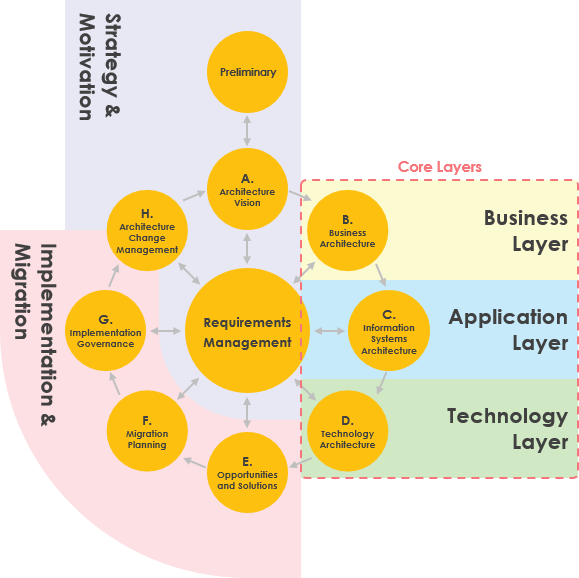A Journey with TOGAF: A Quick Overview
Introduction
In today’s rapidly evolving business landscape, organizations face the constant challenge of aligning their technology capabilities with their strategic objectives. The Open Group Architecture Framework (TOGAF) emerges as a guiding compass in this journey, providing a structured approach to design, plan, implement, and govern enterprise information technology architecture. As businesses strive for agility, innovation, and competitiveness, TOGAF stands as a vital tool to navigate the complexities of enterprise transformation. This guide explores the key components of TOGAF and its architectural domains, offering insights into how this framework empowers organizations to achieve their architectural aspirations.
The Open Group Architecture Framework, commonly known as TOGAF, stands as a formidable framework in the realm of Enterprise Architecture (EA). This comprehensive framework offers a structured approach for organizations to design, plan, implement, and govern their information technology architecture, thereby aligning their technological capabilities with strategic business objectives. TOGAF serves as a guiding beacon for enterprises navigating the complex and ever-evolving landscape of IT systems and processes.
Key Components of TOGAF:
TOGAF comprises several critical components that collectively facilitate the development and management of enterprise architecture:

- Architectural Development Method (ADM): The core of TOGAF, ADM provides a step-by-step methodology for creating and evolving an enterprise architecture. It offers guidance on how to approach architecture development and transformation projects systematically.
- ADM Guidelines and Techniques: TOGAF offers a rich set of guidelines and techniques that assist architects in applying the ADM effectively. These resources empower architects with tools and best practices for each phase of architecture development.
- Architecture Content Framework: This component defines the structure and organization of architectural artifacts and documents. It ensures that all necessary information is captured and communicated effectively during architecture development.
- Reference Models: TOGAF incorporates reference models that aid in the creation of standardized architecture building blocks, making it easier for organizations to reuse proven architectural patterns and solutions.
- Enterprise Continuum: The Enterprise Continuum provides a framework for organizing and classifying architectural assets, making it easier to manage and leverage architecture assets across the organization.
- Architecture Capability Framework: TOGAF emphasizes the importance of building and maintaining an effective architecture capability within an organization. This framework provides guidance on establishing and maturing this capability.
TOGAF Pillars (Core Layers)
TOGAF divides the realm of enterprise architecture into four distinct architectural domains, each addressing specific aspects of the enterprise:

- Business Architecture: This domain delves into business strategy, governance, organization, and the adaptation of existing processes within the organization. It provides a blueprint for aligning business goals and processes with the enterprise’s overarching strategy.
- Applications Architecture: Applications Architecture focuses on structuring and deploying application systems in accordance with business goals, organizational frameworks, and core business processes. It ensures that technology solutions align with the business’s needs and objectives.
- Data Architecture: Data Architecture encompasses the definition of data storage, management, and maintenance within the organization. This domain includes logical and physical data models to ensure data integrity and accessibility.
- Technical Architecture: Also referred to as technology architecture, this domain covers all aspects of hardware, software, and IT infrastructure needed to develop and deploy business applications. It ensures that the technology stack is aligned with the enterprise’s technical requirements.
In essence, TOGAF provides a comprehensive framework that empowers organizations to orchestrate their IT landscape in harmony with their business objectives. It offers a structured approach, a wealth of resources, and a clear roadmap for architects and organizations embarking on the journey of enterprise architecture development and governance.
Summary
In the dynamic world of enterprise architecture, TOGAF offers a beacon of clarity and structure. It comprises essential components like the Architectural Development Method (ADM), guidelines, and techniques, along with the Architecture Content Framework and Reference Models. Furthermore, the Enterprise Continuum and Architecture Capability Framework enhance an organization’s ability to manage architectural assets effectively.
TOGAF’s four architectural domains—Business, Applications, Data, and Technical Architecture—provide specialized insights into aligning business strategy, application systems, data management, and technical infrastructure. As businesses seek to adapt, innovate, and stay competitive, TOGAF equips them with the tools and methodology to orchestrate a harmonious alignment of technology and strategy. This guide embarks on a journey through the world of TOGAF, illuminating the path to effective enterprise transformation.

